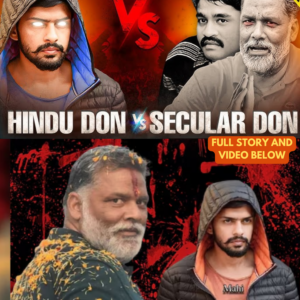In a recent and alarming development, Raj Shekhawat, the chief of the Karni Sena, made headlines with his bold announcement regarding a substantial bounty on the notorious gang leader Lawrence Bishnoi. Shekhawat proclaimed that a reward of ₹11.11 crore would be given to any police officer who successfully encounters Bishnoi. This declaration stems from a deep-rooted rivalry, particularly following the murder of their associate, Sukhddev Singh Gogamedi.
The video of Shekhawat’s announcement has gone viral, drawing significant attention to the escalating gang tensions in the region. Shekhawat’s claims highlighted the urgency of neutralizing Bishnoi’s gang, as he stated that this action is imperative in response to the violence that has claimed lives and instilled fear in the community. His comments reflect a growing sentiment among rival factions seeking revenge and retribution.
Shekhawat revealed that he has been living under constant threat, having received multiple death threats from Bishnoi’s associates. This admission underscores the perilous nature of gang rivalries, where personal safety is often compromised. Shekhawat’s candidness about the threats he faces further amplifies the seriousness of the situation, as he navigates a dangerous landscape marked by violence and retribution.
In a shocking twist, Shekhawat disclosed that an individual named Osama Khan from Bihar has reportedly been offered a contract worth ₹1.5 crore to carry out an assassination on him. This revelation highlights the extreme lengths to which gang members are willing to go to eliminate their rivals. The existence of such a bounty not only puts Shekhawat’s life at risk but also indicates a broader trend of violence permeating the underworld.
As tensions rise, law enforcement agencies are stepping up their efforts to tackle this growing threat. Police operations aimed at apprehending Lawrence Bishnoi and his associates have intensified, with recent arrests made in Delhi. These actions signify a concerted effort by authorities to dismantle Bishnoi’s network and restore order in the affected areas.
In addition to the arrests, the National Investigation Agency (NIA) has announced a reward of ₹10 lakh for information leading to the capture of Anmol Bishnoi, Lawrence’s brother. This move reflects the NIA’s commitment to addressing organized crime and underscores the importance of community cooperation in providing critical information to law enforcement.
The dynamics of this gang rivalry illustrate a complex web of power struggles, where loyalty and betrayal often dictate actions. Shekhawat’s motivations appear to be fueled not only by a desire for revenge but also by the need to assert dominance over rival factions. This ongoing conflict highlights the volatility of gang affiliations and the consequences of violent confrontations.
As this situation unfolds, it remains to be seen how law enforcement will navigate the challenges posed by entrenched gang rivalries. The stakes are high, and the potential for further violence looms large. Authorities are tasked with not only apprehending key figures but also addressing the underlying issues that perpetuate such conflicts.
The growing media coverage surrounding these events serves to inform the public while simultaneously heightening tensions between rival groups. The interplay between media narratives and gang activities can often exacerbate violence, as rival factions vie for control and public perception. In the face of such challenges, it is crucial for law enforcement to remain vigilant and proactive.
In conclusion, the recent developments involving Raj Shekhawat and Lawrence Bishnoi shed light on the dangerous realities of gang rivalries in the region. With substantial bounties being placed on lives and law enforcement efforts intensifying, the situation remains precarious. As the community watches closely, the hope for a resolution lies in the effective dismantling of these criminal networks and the restoration of peace.
.
.
.
.
News
Amitabh Bachchan behaved badly with his daughter-in-law Aishwarya Rai | Amitabh IGNORE Aishwarya Rai
In recent weeks, a wave of speculation has emerged suggesting that all may not be well between former Miss World Aishwarya Rai and the iconic Bachchan family. This speculation has captured the attention of fans and the media, as rumors…
Amitabh gave a message to daughter-in-law Aishwarya Rai, said “No matter how your house is, it is yours”
Amitabh Bachchan, the iconic figure of Indian cinema, has a longstanding tradition of engaging with his audience through social media. He often shares reflections on his life, career, and personal philosophies. Recently, a particular post of his has stirred significant…
Salman Khan vs Lawrence Bishnoi | Why it is Happening? |
Salman Khan vs Lawrence Bishnoi | Why it is Happening? | The tension between Bollywood superstar Salman Khan and gangster Lawrence Bishnoi has become a hot topic in recent news. This clash is not just a simple feud; it embodies…
Lawrence Bishnoi Vs Pappu Yadav | Bishnoi Targets Anti-India Mafia?
In the ever-evolving landscape of India’s criminal underworld, a new chapter is unfolding, marked by the dramatic confrontation between notorious gangster Lawrence Bishnoi and the infamous Bihar don, Pappu Yadav. This rivalry has escalated recently, with Bishnoi’s gang issuing a…
LAWRENCE BISHNOI VS SALMAN KHAN, PAKISTANI PUBLIC REACTION AFTER NADEEM KHAN VIRAL VIDEO, REAL TV
The recent controversy involving Bollywood superstar Salman Khan and Lawrence Bishnoi has sparked intense discussions across communities, especially concerning allegations of animal cruelty. The speaker, representing a particular community, emphasizes that if there is evidence that Khan has harmed a…
LAWRENCE BISHNOI’S DIWALI GIFT TO PAPU YADAV LIVE, AFTER NADEEM KHAN & SALMAN KHAN, LATEST NEWS
In a recent live discussion, significant attention was drawn to the ongoing tensions surrounding Pappu Yadav and Lawrence Bishnoi, especially in light of recent developments involving prominent figures like Nadeem Khan and Salman Khan. The speaker began by addressing the…
End of content
No more pages to load











